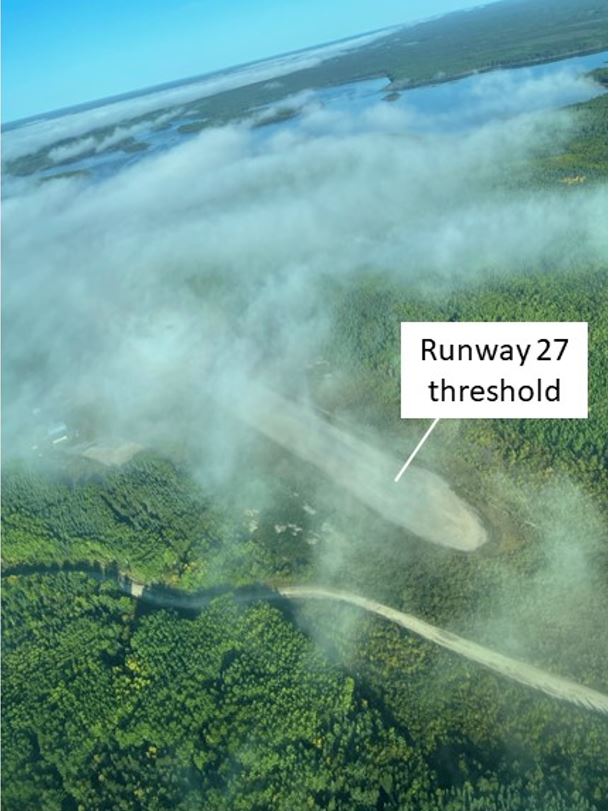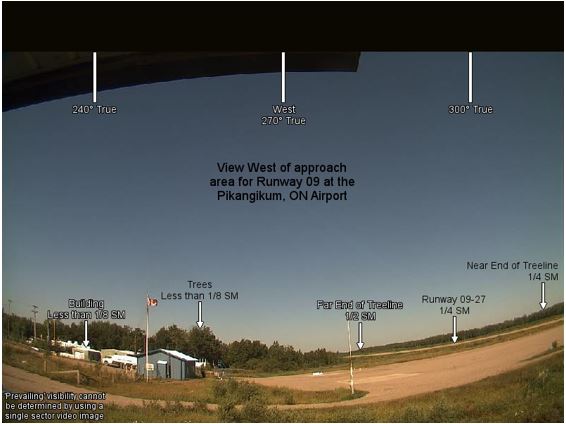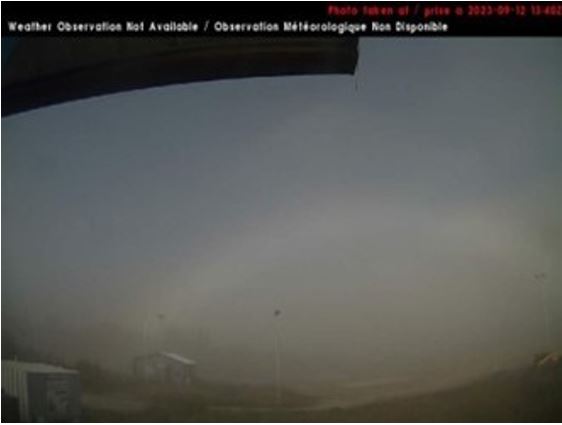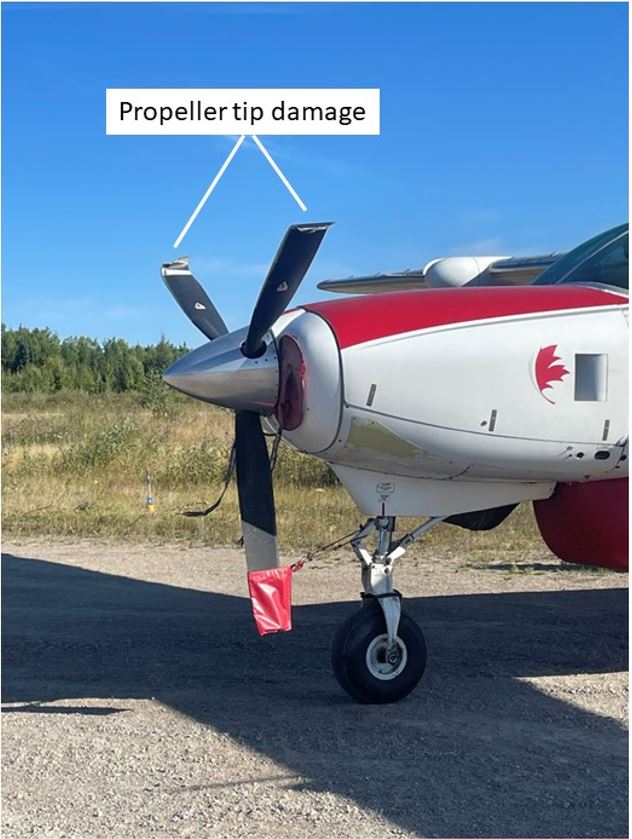Runway overrun
Superior Airways Limited
Cessna 208B, C-FYMK
Pikangikum Airport, Ontario
The Transportation Safety Board of Canada (TSB) investigated this occurrence for the purpose of advancing transportation safety. It is not the function of the Board to assign fault or determine civil or criminal liability. This report is not created for use in the context of legal, disciplinary or other proceedings. See Ownership and use of content. Masculine pronouns and position titles may be used to signify all genders to comply with the Canadian Transportation Accident Investigation and Safety Board Act (S.C. 1989, c. 3).
History of the flight
On 12 September 2023, the Superior Airways Limited (Superior) Cessna 208B aircraft (registration C‑FYMK, serial number 208B2219) was scheduled for 2 daytime visual flight rules (VFR) return flights from Red Lake Airport (CYRL), Ontario, to Pikangikum Airport (CYPM), Ontario. The pilot arrived at CYRL at 0545All times are Central Daylight Time (Coordinated Universal Time minus 5 hours). and proceeded to check the weather and conduct an aircraft pre-flight walkaround. The aircraft departed on a cargo-only flight at 0630 and landed at CYPM at 0655. The visibility at CYPM at the time of landing was approximately 2 statute miles (SM) in mist. The aircraft’s cargo was unloaded, and the aircraft departed CYPM at 0710 and arrived at CYRL at 0735.
The pilot then prepared the aircraft for the 2nd flight by ensuring the cargo and fuel were loaded and completing the weight and balance calculations. The pilot and 6 passengers then embarked and the aircraft departed on the VFR flight to CYPM at 0815.
The take-off, climb, and cruise portions of the flight from CYRL to CYPM were conducted in visual meteorological conditions. As the occurrence aircraft approached CYPM, the pilot noticed fog over the airport (Figure 1) and the community of Pikangikum. The pilot activated the aircraft radio control of aerodrome lighting and was able to see the east end and threshold of Runway 27. The pilot continued the visual approach to Runway 27 with an approach speed of approximately 115 knots indicated airspeed and flaps set to 20°.
At 0840, the aircraft touched down approximately 1850 feet from the threshold of Runway 27 at approximately 90 knots. While the aircraft was in the flare for landing, visibility was reduced significantly in a fog layer. During the rollout, the pilot could not see the end of the runway owing to the fog. He applied the brakes and selected the power lever to the beta range,Beta range on the Cessna 208B “enables the pilot to control propeller blade pitch from idle thrust back through a zero or no-thrust condition.” (Source: Cessna Aircraft Company, Pilot’s Operating Handbook And FAA Approved Airplane Flight Manual, Grand Caravan Model 208B, Revision 2 [28 December 2010], Section 7: Airplane And Systems Description, Power Lever, p. 7–43.) but he did not use reverse. As the aircraft was slowing, the pilot observed the runway end lights go by, and the aircraft overran the end of the runway at approximately 35 knots.
The aircraft came to rest approximately 50 feet past the turnaround bay, in grass and bushes. There were no injuries to the pilot or passengers. The emergency locator transmitter did not activate. The pilot subsequently contacted a company aircraft that was scheduled to land 8 minutes later by radio to tell that pilot not to land. The occurrence pilot and passengers then exited the aircraft uneventfully.
Pilot information
The pilot had 530 total flight hours. He completed his commercial pilot licence training and his multi-engine instrument flight rules (IFR) rating (Group 1) in September 2022. He was hired by Superior in March 2023, where he worked in a ground-based position and as a Piper PA-31 first officer, accumulating approximately 250 flight hours, including approximately 50 hours in instrument meteorological conditions. In August 2023, Superior began training the pilot on the Cessna 208B. He completed his day VFR pilot competency check on 28 August 2023. He also completed 28.5 hours of line indoctrination training and obtained a line indoctrination sign off on 09 September 2023. The occurrence flight was on the pilot’s first day of work as a single pilot and it was his 3rd flight after the completion of his line indoctrination training.
The pilot had a valid medical certificate. According to information gathered during the investigation, there was no indication that the pilot’s performance was affected by medical or physiological factors.
Weather information
CYPM does not have a weather reporting station. The nearest station is at CYRL, located 46 nautical miles to the south. The CYRL aerodrome routine meteorological report issued at 0800 indicated:
- Light winds, clear sky conditions
- Visibility of 15 SM
- Temperature 2 °C, dew point 1 °C
The CYRL aerodrome forecast issued at 0540 and valid from 0600 to 1800 indicated:
- Winds from 110° true at 5 knots
- Visibility greater than 6 SM, clear sky conditions
- A 30% probability that between 0600 and 0900, there would be a visibility of 1 SM in mist with scattered cloud at 300 feet above ground level
From 0900:
- Winds from 120° true at 10 knots
- Visibility greater than 6 SM, clear sky conditions
The graphic area forecast for the area surrounding CYPM, issued at 0629 and valid at 0700, indicated:
- Clear sky conditions
- Visibility greater than 6 SM and local areas with visibility of 1 SM in mist, dissipating by 0900
NAV CANADA has a camera site at CYPM, which takes periodic pictures of the weather conditions and makes them publicly available on its flight planning website along with a reference image (Figure 2). An image depicting the weather conditions at CYPM was captured at 0840 (Figure 3).
(Source: NAV CANADA)
Company information
Superior is authorized by Transport Canada to operate under Subpart 702 (Aerial Work) and Subpart 703 (Air Taxi Operations) of the Canadian Aviation Regulations (CARs). The company is approved for VFR and IFR flights. The occurrence flight was conducted under CARs Subpart 703.
Although Superior is approved for IFR flights, pilots trained on the Cessna 208B who do not meet the minimum experience requirementsTransport Canada, Commercial Air Services Standards (CASS), Standard 723: Air Taxi – Aeroplanes, section 723.86: Minimum Crew – Single Pilot IFR Requirements. to operate the aircraft single pilot for IFR flights are trained and given a pilot competency check as day VFR pilots and are subsequently restricted to operating day VFR flights only. The pilot of this occurrence was restricted to day VFR flights.
Aircraft information
The Cessna 208B aircraft is a high-wing, fixed-landing-gear aircraft equipped with a Pratt & Whitney Canada PT6A-114A turboprop engine and a McCauley 3GFR34C703 constant-speed reversible propeller. The occurrence aircraft, manufactured in 2010, is equipped for day VFR operations, for night operations, and for IFR operations. The 2 cockpit seats are fitted with 5-point safety belts and the passenger seats with 3-point safety belts.
The instrument panel includes a Garmin G1000 system with synthetic vision technology. The use of synthetic vision technology can enhance the perspective when flying in conditions of reduced visibility. It provides a virtual flight reference on the G1000 display, giving the pilot a 3-dimensional topographic landscape map of the upcoming terrain, including runways.
The occurrence aircraft was not equipped with a flight data recorder or a cockpit voice recorder, nor was it required to be by regulation.
The investigation determined that the aircraft’s centre of gravity was within the manufacturer’s prescribed limits, and its weight at takeoff was 8012 pounds and at landing approximately 7850 pounds. The aircraft had no known deficiencies, and there was no indication of an aircraft system malfunction contributing to this occurrence. The aircraft sustained minor damage during the event, including damage to the propeller blade tips (Figure 4).
Airport information
CYPM is located in the community of Pikangikum First Nation in northern Ontario. The airport has 1 runway, Runway 09/27, that runs east-west and has a gravel surface. It is 3508 feet long and 100 feet wide. There are 2 area navigation instrument approaches published for the airport, 1 for Runway 09 and the other for Runway 27.
Landing procedures
The Transport Canada Aeronautical Information Manual defines the touchdown zone as “[t]he first 3 000 ft of the runway or the first third of the runway, whichever is less, measured from the threshold in the direction of landing.”Transport Canada, TP 14371E, Transport Canada Aeronautical Information Manual (TC AIM), GEN – General (23 March 2023), Section 5.1: Glossary of Aeronautical Terms, p. 37. According to this definition, the touchdown zone for Runway 27 at CYPM would be the first 1169 feet.
Landing performance calculations made using the Cessna 208B pilot’s operating handbook / aircraft flight manual (POH/AFM) for a landing weight of 7850 pounds indicate a short field landing distance to clear a 50-foot obstacle at 1620 feet and a ground roll distance of 830 feet.Cessna Aircraft Company, Pilot’s Operating Handbook And FAA Approved Airplane Flight Manual, Grand Caravan Model 208B, Revision 2 (28 December 2010), Section 5: Performance, Short Field Landing Distance, pp. 5–60 to 5–63. Superior’s Cessna 208B standard operating procedures (SOPs) state that “[t]ouchdown MUST take place in the first 500 feet for runways of 3,000 feet or less.”Superior Airways, C208B Grand Caravan Standard Operating Procedures for Superior Airways (Red Lake) (09 September 2014), Section: Landing, p. 50. There is no SOP guidance for touchdown on longer runways.
The SOPs also state that “[n]ormal landings are accomplished with 30 Flaps”Ibid. and that “[t]he beta range may be used after touchdown to aid in slowing the aircraft; however the use of reverse should be limited to situations requiring maximum performance.”Ibid. For gravel operations, the SOPs also state “[e]ngine reverse shall not be used unless absolutely necessary; this is only acceptable to prevent the aircraft from running off the runway environment, in the event braking is insufficient.”Ibid., p. 51.
Visual flight rules requirements
The CARs outline the minimum visual meteorological conditions for VFR flight, which stipulate that, in uncontrolled airspace and below 1000 feet above ground level, an aircraft must maintain visual reference to the surface, remain clear of cloud, and, during the day, ensure that visibility is at least 2 SM.Transport Canada, SOR/96–433, Canadian Aviation Regulations, section 602.115. While Transport Canada can authorize operators to operate in lower visibility conditions than those listed above, Superior did not have this authorization.
TSB Watchlist
The TSB Watchlist identifies the key safety issues that need to be addressed to make Canada’s transportation system even safer.
Runway overruns are a TSB Watchlist 2022 issue and have been a Watchlist issue since 2010. The TSB has investigated and is in the process of investigating many runway overruns, including this occurrence, that have taken place in recent years.Recent TSB investigations of runway overruns include occurrences A23O0046 (ongoing), A22O0161 (ongoing), A22Q0025 (ongoing), A21O0127, A21Q0087, and A21O0066.
When a runway overrun occurs during a landing, it is important that the aircraft has an adequate safety area beyond the end of the runway to reduce adverse consequences. Despite the actions taken to date, the number of runway overruns in Canada has remained constant since 2005 and demands a concerted effort to be reduced.Transportation Safety Board of Canada, “TSB Watchlist 2022: Runway overruns”, at tsb.gc.ca/eng/surveillance-watchlist/aviation/2022/air-02.html (last accessed on 01 October 2024).
Safety action taken
Following this occurrence, Superior took the following safety action:
- Modified the VFR stabilized approach criteria in the Cessna 208B SOPs to include:
- The runway’s full length must be visible before landing.
- The target approach speed at 500 feet above ground level will be 100 knots and within a range between 110 knots and 95 knots.
- Flaps will be set at 30° when landing in winds less than 10 knots and at 20° when landing in winds greater than 10 knots.
- Touchdown is to be completed in the first 1000 feet of the runway.
- Requires new captains to complete a captain’s risk assessment form before every flight that includes weather minima, as well as other criteria, to be met in order for the pilot to dispatch on a flight.
- Installed GPS (global positioning system) tracking devices in all aircraft to allow monitoring of aircraft fleet.
Safety messages
Pilots must be aware that operating in fog can lead to a loss of situational awareness during the approach and landing.
It is important for pilots to land in the touchdown zone, and to use all available means, including reverse thrust, if needed, to slow the aircraft.
This report concludes the Transportation Safety Board of Canada’s investigation into this occurrence. The Board authorized the release of this report on 30 October 2024. It was officially released on 13 November 2024.



